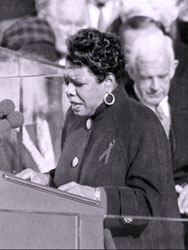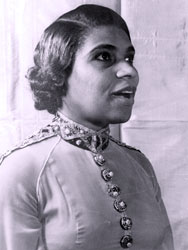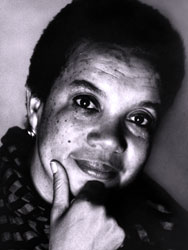
Black History Resources
Arts and Architecture
 "I believe in living a poetic life, an art full life. Everything we do from the way we raise our children to the way we welcome our friends is part of a large canvas we are creating." -Maya Angelou
"I believe in living a poetic life, an art full life. Everything we do from the way we raise our children to the way we welcome our friends is part of a large canvas we are creating." -Maya Angelou Black history in Pennsylvania is not just found in the stories of the people, places, and events. It can also be discovered by the things that have been left behind. This section is devoted to the arts and architecture envisioned and created by the people in Pennsylvania's Black history.
Sculptor C. Edgar Patience was an African American artist who lived in the coal region of Northeastern Pennsylvania. He sculpted carvings out of the anthracite coal found there. His work is on display at the Pennsylvania Anthracite Heritage Museum in Scranton.
Beginnings
 "Leadership should be born out of the understanding of the needs of those who would be affected by it." -Marian Anderson
"Leadership should be born out of the understanding of the needs of those who would be affected by it." -Marian Anderson Every story has its beginning. The story of Black history in Pennsylvania does not only begin when the first Africans set foot on the shores of the Delaware River. Each chapter in this complex story also has a start, from the singer, Marian Anderson, whose performace at the Lincoln Memorial opened the doors for other African American concert artists, to Nicholas Biddle, the first to shed blood in the American Civil War. History in Pennsylvania would not be the same without all these beginnings.
Nick Biddle is claimed to be the "first man to shed blood in the Civil War," yet as escaped slave living in Pottsville, Schuylkill County, Biddle was not a member of the military unit nor was his wound inflicted during battle.
Introducing Trailblazers - the PHMC has identified a group of African American men and women whose signification in history is statewide and often national, and an individual with a strong connection to PHMC. They are called Trailblazers.
Cumberland Willis Posey Sr. was an engineer turned entrepreneur. His association with the Diamond Coke and Coal Company helped him become the wealthiest African American men in Pittsburgh.
Eric Ledell Smith was a historian for the PHMC from 1993 to 2008. His passion and exuberance for the accomplishments of all people, especially those that had little or no recognition in history or popular culture, brought him to complete the Trailblazers exhibition in The State Museum of Pennsylvania.
Marian Anderson (1897–1993), a classical music and opera singer was a native of Philadelphia. In 1939, she was denied permission by the Daughters of the American Revolution (DAR) to perform at Constitution Hall. Eleanor Roosevelt helped arrange for her to perform in front of the Lincoln Memorial. Anderson’s legacy stands equally on the quality of her voice and performances and on the dignity she projected while faced with the adversity and confrontation of prejudice
Slavery and Resistance - Learn about early African American history in Pennsylvania from the beginings of the slave trade in the mid-1600s to the opposition and resistance that continued into the late 19th century.
Change
 "Change will not come if we wait for some other person or some other time. We are the ones we've been waiting for. We are the change that we seek." -Barack Obama
"Change will not come if we wait for some other person or some other time. We are the ones we've been waiting for. We are the change that we seek." -Barack Obama History is always filled with change. It is not always apparent at the time that change is occurring. But looking back after the fact can help us to recognize the change that has happened. Even though we may not be able to pinpoint an exact moment in time or key event, we can study the differences between then and now. This helps provide a roadmap to change the misfortunes and injustices of today so that we can create a better community for tomorrow.
Desegregation of Pennsylvania Schools ended the practice of separate but equal schools based on race. Elias H. Allen tried to enroll his two children into an all-white Meadville school. He appealed to the Crawford County Court of Common Pleas and sued the Crawford County School Board.
Stephen Smith Letter - Stephen Smith was a successful African-American businessman who lived in Columbia, Lancaster County. In 1834, his office was destroyed by a mob of white men demanding the sale of African American owned property. Mr. Smith wrote to his state senator, John Strohm, reminding him of the need for change in Columbia.
Labor and Occupation to 1860 and Labor and Occupation 1860 to WWII investigates occupation for both free and enslaved African Americans from the late seventeeth through World War II.
Community
 "When I fight about what is going on in the neighborhood, or when I fight about what is happening to other people's children, I'm doing that because I want to leave a community and a world that is better than the one I found." -Marian Wright Edelman
"When I fight about what is going on in the neighborhood, or when I fight about what is happening to other people's children, I'm doing that because I want to leave a community and a world that is better than the one I found." -Marian Wright Edelman A community is more than its geographic boundaries. It is more than than its leadership, even more than the homes or businesses that dot the streets. A community is its people, those who have come together and identify with one another whether due to circumstance, locality, or even race. Pennsylvania is filled with examples of communities that have worked together to make their mark in history. These communities are in common throughout our history because of its people, and as PHMC historian Eric Ledell Smith had said, "There is no 'Black history,' 'women’s history,' or 'Native American history.' There is only human history."
African Americans in Pennsylvania - This pamphlet provides a brief overview and timeline of the African American community in Pennsylvania.
Charles "Teenie" Harris recorded a community through his photography of Pittsburgh neighborhoods. He was a freelance and staff photographer from 1938 until his retirement in 1975 for the internationally renowned Pittsburgh Courier.
Religion contains a historical account of African Americans and religion in Pennsylvania.
Education focuses on the multifaceted history of African American education in Pennsylvania from the eighteenth through late twentieth century.
Empowerment
 "We are not makers of history. We are made by history."
"We are not makers of history. We are made by history." Empowerment has long had a role in Black history in Pennsylvania. In this section, you will find many examples from which it was granted through legal means, such as by "An Act for the Gradual Abolition of Slavery of 1780"; to that which was fought for through the Civil War by the U.S. Colored Troops; to empowerment that was petitioned, protested, and marched for by Black civil rights leaders.
Hubert Fountleroy Julian (1897-1983) was a famous Black aviator, widely known as "The Black Eagle."
Gradual Abolition of Slavery - On March 7, 1780 the Pennsylvania General Assembly passed this act, the first of its kind in America, which called for the gradual freeing of all slaves in Pennsylvania.
Quest for Civil Rights - Learn about the laws and leadership that worked both for and against equal civil rights for African Americans.
African American and Civil Rights in Pennsylvania describes Pennsylvania's role in civil rights. It focuses on laws and court cases that have shaped the civil rights movement.
Additional Resources
Guide to African American Resources - This resource, taken from "Guide to African American Resources at the Pennsylvania State Archives" by Ruth E. Hodge, is an easy-to-use reference for identifying and locating information available at the Pennsylvania State Archives relating to African Americans.
Vigilance In Pennsylvania: Underground Railroad Activities In The Keystone State, 1837-1861 By Dr. Matthew Pinsker (PDF) was prepared from a recommendation made in the 1990s by the Pennsylvania Historical and Museum Commission's Black History Advisory Committee to provide an assessment of scholarship on the Underground Railroad in Pennsylvania. It was created by Dr. Matthew Pinsker, now of the History Department of Dickinson College, and presented at the annual PHMC Conference on Black History in Pennsylvania on April 27, 2000. There has been additional research on the Underground Railroad in Pennsylvania since this was written, but this study, however outdated, provides an excellent overview.
"In Immortal Splendor" Wilkes-Barre's Fugitive Slave Case of 1853 (PDF) - Published in Spring 2008, William C. Kashatus guides readers on a whirlwind visit to mid-nineteenth-century Wilkes-Barre.
Finding Sanctuary at Montrose (PDF) - William Kashatus writes about Pennsylvania abolitionists.
Ethnic and African American related books from ShopPAHeritage.com.
Videos authored and provided by Commonwealth Media Services.
Running time: 38:21
Running time: 20:35
Communities in Common: Black History in Pennsylvania study
After receiving a Preserve America Grant in 2006, the Pennsylvania Historical and Museum Commission (PHMC), Harrisburg, and the African American Museum of Philadelphia embarked on an exciting journey to chronicle the historic context of African Americans in Pennsylvania and to conduct a survey of the history, changing demographics, and built environment of nine geographically and economically distinct African American communities in the Commonwealth.
The main objective of this history study is to serve as a social, cultural, economic, political, and religious history, as it examines the people, events, and places that make Pennsylvania’s African American historical legacy—spanning the seventeenth century to the twentieth—rich and multi-layered. It is also intended as a guide for scholars and laypeople alike wishing to nominate buildings, sites, structures, and objects of African American significance to the National Register of Historic Places and to PHMC’s State Historical Marker Program by providing the necessary historical context to aid them.
The history study employed disparate secondary sources on the African American experience in Pennsylvania, as well as a great number of primary source materials including (but not limited) to: tax, land and Census records, newspaper articles, amateur, local, and county histories, personal journals, diaries, ledgers, and records (gathered from historical societies, libraries, museums and private collections, electronic databases).
Exhaustive research, intensive analysis, and painstakingly careful interpretation have produced an intricate, multifaceted narrative history of Pennsylvania’s African Americans that is at once both historiographic and forward-looking. In addition, the study is augmented by the voices and recollections of individuals who lived and witnessed this history.
The study is invaluable as a template for individuals and organizations throughout Pennsylvania who wish to study and interpret the African American cultural and historical legacies of their region, community, or neighborhood.
Please select from the a chapter below.
- Chapter 1: Slavery and Resistance
- Chapter 2: Religion
- Chapter 3: Labor and Occupation up to 1860
- Chapter 4: Labor and Occupation: 1860 to 1965
- Chapter 5: Education
- Chapter 6: Social Affiliations
- Chapter 7: Sports and Recreation
- Chapter 8: Quest for Civil Rights
- Bibliography
The activity that is the subject of this history study and web page has been financed in part with Federal funds from the National Park Service, U.S. Department of the Interior. However, the contents and opinions do not necessarily reflect the views or policies of the Department of the Interior, nor does the mention of trade names or commercial products constitute endorsement or recommendation by the Department of the Interior.
This program receives Federal financial assistance for identification and protection of historic properties. Under Title VI of the Civil Rights Act of 1964, Section 504 of the Rehabilitation Act of 1973, and the Age Discrimination Act of 1975, as amended, the U.S. Department of the Interior prohibits discrimination on the basis of race, color, national origin, disability or age in its federally assisted programs. If you believe you have been discriminated against in any program, activity, or facility as described above, or if you desire further information, please write to: Office of Equal Opportunity, National Park Service, 1849 C Street, N.W., Washington, D.C. 20240.